Sex
Boy or Girl: Couples Trying to Load the Dice
Is a baby’s sex just the luck of the draw, or can parents choose?
Posted August 21, 2018
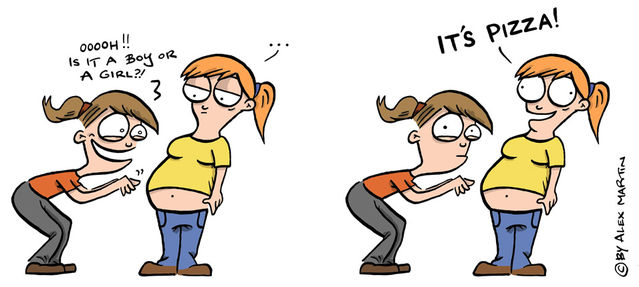
Without modern medical science, a baby’s sex would remain unknown until birth. But many mothers today know long beforehand whether a baby will be male or female. Routine ultrasound scans reveal fetal genitals a third of the way through pregnancy, and genetic tests identify sex even earlier. Yet basic questions remain. Is a baby’s sex like coin tossing, or can the male:female ratio be skewed? If sex bias occurs, does it happen through sperm sorting before fertilization or mortality differences in the womb after conception?

Do biased sex ratios occur naturally?
All mammals share a universal mechanism for sex determination, so — other things being equal — approximately equal numbers of females and males should be conceived. Every member of a species typically has a standard number of chromosome pairs including two sex chromosomes. Females have two X-chromosomes; males have one X- and one Y-chromosome. Production of eggs and sperms halves the number of chromosomes, so each has only one sex chromosome. An egg always has an X, whereas a sperm may have either X or Y. A sperm fertilizing an egg hence simultaneously determines the sex and restores the standard chromosome number.
Random fertilization should yield equal numbers of male and female embryos. So a key question is whether detectable differences occur and, if so, whether natural selection drives them.
Biased sex ratios in animals
In 1973, Robert Trivers and Dan Willard published a widely influential, largely theoretical essay. They argued that ambient conditions might cause natural selection to favor greater investment in sons or daughters by skewing sex ratios at birth. A brother would be expected to reproduce more successfully than a sister if both are in good condition; but the opposite should apply if both are below par. This yields the testable prediction that females in good condition should invest more in sons, while females in poor condition should invest more in daughters. Trivers and Willard cited mammal and human examples indicating that mothers do indeed increasingly tend to produce more daughters with declining physical condition.
A 1986 paper by Timothy Clutton-Brock and Glenn Iason reviewed variation in sex ratios at birth among mammals. They listed numerous studies clearly documenting significant variation, but found no consistent trends for a particular ratio to have a selective advantage. Reported trends did not closely match predictions from the Trivers-Willard model or any alternative. But some studies did indicate that sex ratios do differ according to factors such as a mother’s social rank and her physical condition at conception.
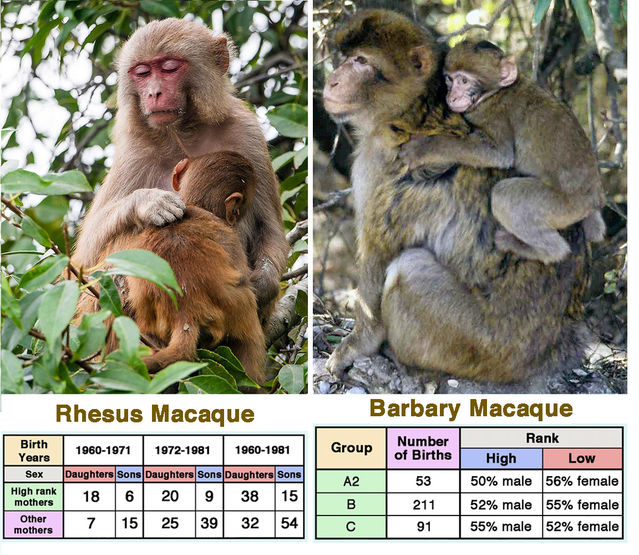
Studies of variation in sex ratios among primates have yielded results resembling those from other mammals. While convincing evidence of differences exists, no consistent explanation has emerged. Two reports on macaques, both with large samples, aptly illustrate this. In 1982, Michael and Ann Simpson reviewed data from six small captive groups of Rhesus macaques covering two decades. Analysis of 139 births revealed that, although the overall sex ratio was close to 1:1, high-ranking mothers were more than twice as likely to have daughters, while other mothers were almost twice as likely to bear sons. This highly significant difference directly contradicts the Trivers-Willard prediction. Yet confirmatory results emerged from a 1987 review by Andreas Paul and Jutta Küster of 355 births in three social groups over eight years in a semi-captive population of Barbary macaques. There was a highly significant difference between high-ranking females, bearing a greater proportion of sons, and low-ranking females, predominantly giving birth to daughters.
In a nutshell, mammal studies have not provided a cohesive theoretical basis for interpreting skewed sex ratios in humans.
Human sex ratios
Much has been written about deviations from a balanced sex ratio in humans. It has often been claimed that the sex ratio at conception is biased in favour of males and widely accepted that, on average, about 105 boys are born for every 100 girls. However, until quite recently reliable data on sex ratio from conception to birth were lacking.
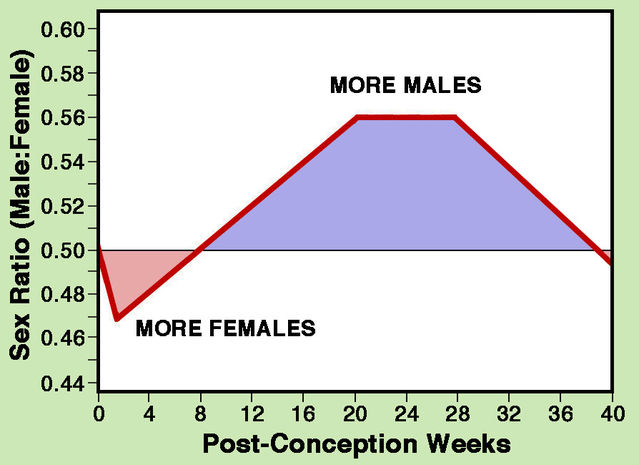
In 2015, Steven Orzack and colleagues combined information from 3- to 6-day-old embryos, induced abortions, fetal membrane samples, miscarriages and live births. They estimated that the sex ratio is actually balanced at conception. For a couple of weeks thereafter, excess male mortality may shift the ratio to favour females, but excess female mortality subsequently generates a gradually increasing male bias until mid-pregnancy. From then until the end of the seventh month, the sex ratio remains steady at about 56% males to 44% females. Over the last two months of pregnancy a return to excess male mortality again reduces the sex ratio.
But that is an average picture. Can processes acting before or after conception affect sex-ratios in individual cases?
Parental choice of fetal sex?
A persistent theme with respect to conceiving a child of the desired sex has been timing of coitus in the menstrual cycle. Starting in 1960, Landrum Shettles exerted a strong influence that still continues. He claimed that conception of a boy is favored by an alkaline douche preceding coitus (with rear entry to maximize penetration) on the day of ovulation and female orgasm preceding or coinciding with male orgasm. Contrastingly, conception of a girl is supposedly fostered by an acidic douche preceding shallower face-to-face coitus without female orgasm 2-3 days before ovulation. He opined that Y-bearing sperm swim faster than X-bearers and also decay more rapidly.
In 1970, from a small sample of around 40 births, Shettles reported a success rate of 85%. A year later, together with journalist David Rorvik, he published a book now in its sixth edition: How to Choose the Sex of Your Baby: The Method Best Supported by Scientific Evidence. Expansively, the preface claims: “Millions of people throughout the world have used the Shettles method with consistent good results, making us the past, the present, and, we trust, the future number-one guide to sex selection on the planet.”
Bursting the bubble
Decades-long perpetuation of the Shettles method is puzzling, given a dearth of independent evaluations. Indeed, the best-documented reports consistently indicate the exact opposite: Coitus close to ovulation favours conception of girls, whereas coitus a few days before or after ovulation produces more boys.
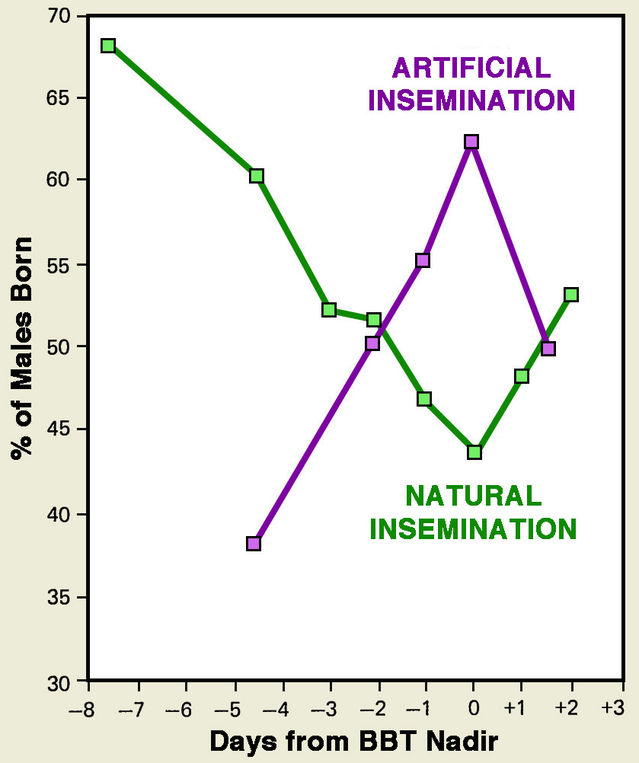
A 1971 paper by William James suggesting a potential link between insemination date and sex ratio at birth prompted Rodrigo Guerrero to report convincing evidence three years later. Inferring ovulation times from the rise in basal body temperature (BBT) for 1318 conception cycles, Guerrero found significant sex ratio differences. With natural conceptions, male births occurred in 68% of cases with coitus six or more days before the BBT rise, whereas coitus on the day of the rise produced 56% female births. Curiously, conceptions with artificial insemination (AI) showed opposite results: 39% male births at three or more days before the BBT rise, increasing to 62% on the day of the rise. Other investigators have reported similar results with conceptions from AI, but they have yet to be convincingly explained. Ironically, however, to document their method Shettles and Korvik relied heavily on data from one physician who specialized in using artificial insemination!
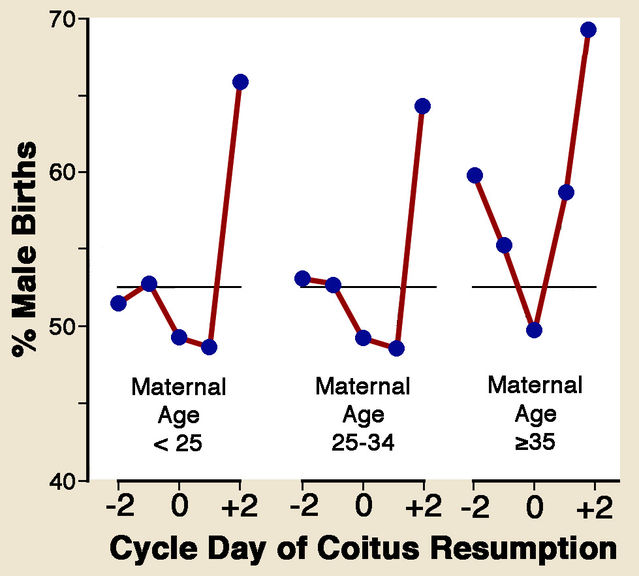
In 1979, Susan Harlap reported results from another study that is particularly striking because of its ingenuity and impressive sample size (3658 births). She examined data from Orthodox Jewish women observing the ritual practice of sexual separation (niddah), forbidding coitus during menstruation and for seven days thereafter. Traditionally, coitus is resumed on the evening of the seventh day, following a ritual bath (mikve). In principle, this practice should favour coitus close to mid-cycle ovulation. But if menstruation is over-long or the ritual bath is delayed beyond a week, coitus may occur after ovulation. For each woman, Harlap estimated the timing of resumed coitus relative to ovulation inferred from previous cycles and the total duration of sexual abstinence. She found a significantly higher proportion of male births (65%) with women who resumed coitus two days after ovulation. The proportion of male births was below 50% with coitus on the day of ovulation or the day after, but somewhat above 50% for the two days preceding ovulation.
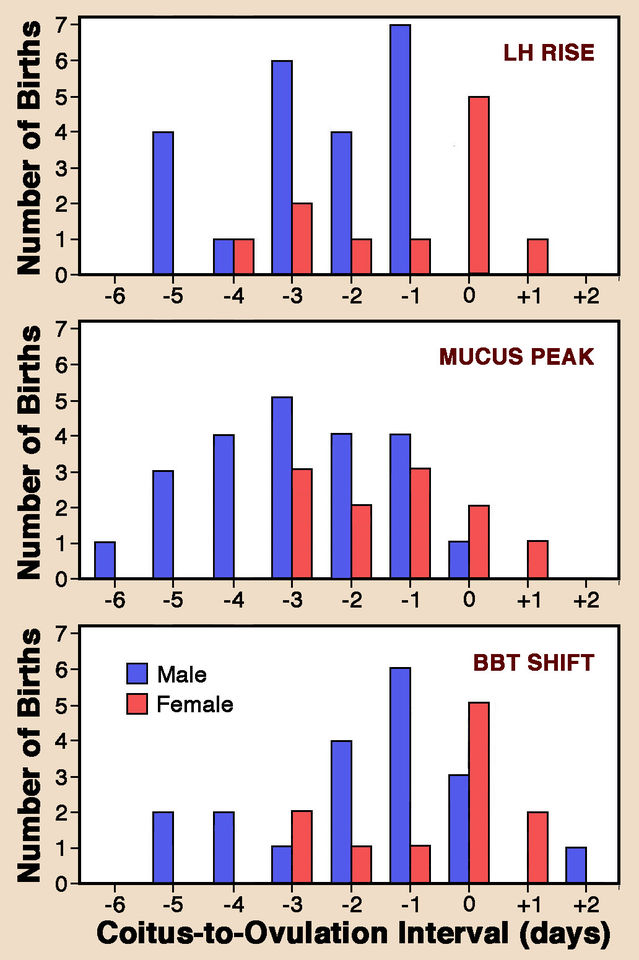
Undoubtedly, despite an inevitably limited sample of 33 pregnancies, the most effective investigation of choosing offspring sex by timing coitus relative to ovulation was reported by John France and colleagues in 1984. In this prospective study, ovulation time was tracked by monitoring luteinizing hormone (LH), the BBT rise and cervical mucus. Participants wishing to choose a baby’s sex were explicitly instructed to use the Shettles method. Conception of a male child proved to be more likely (68%) when coitus and ovulation were separated by an interval greater than two days. By contrast, most female infants (64%) were conceived with a sperm present in the mother's reproductive tract for no more than a day. Although the trend did not quite reach statistical significance, France and colleagues justifiably concluded: “The results clearly refute the theory that intercourse close to ovulation favors male conceptions.”
Take-home message
Although departures from a balanced sex ratio clearly do occur, findings are inconsistent. Moreover, the oft-touted link between a baby’s sex and timing of coitus permits, at best, only a shift in the odds of conception of a boy or girl. Nonetheless, the Shettles method evidently conflicts with the overwhelming majority of scientific findings.
References
Carson, S.A. (1988) Sex selection: the ultimate in family planning. Fertility & Sterility 50:16-19.
Clutton-Brock, T.H. & Iason, G.R (1986) Sex ratio variation in mammals. Quarterly Review of Biology 61:339-374.
France, J.T., Graham, F.M., Gosling, L., Hair, P. & Knox, B.S. (1992) Characteristics of natural conceptual cycles occurring in a prospective study of sex preselection: fertility awareness symptoms, hormone levels, sperm survival, and pregnancy outcome. International Journal of Fertility 37:244-255.
Guerrero, R. (1974) Association of the type and time of insemination within the human menstrual cycle with the human sex ratio at birth. New England Journal of Medicine 291:1056-1059.
Guerrero, R. (1975) Type and time of insemination within the menstrual cycle and the human sex ratio at birth. Studies in Family Planning 6:353-371.
James, W.H. (1971) Cycle day of insemination, coital rate and sex ratio. Lancet 297:112-114.
Orzack, S.H., Stubblefield, J.W., Akmaev, V.R., Colls, P., Munné, S., Scholl, T., Steinsaltz, D. & Zuckerman, J.E. (2015) The human sex ratio from conception to birth. Proceedings of the National Academy of Sciences U.S.A. 112: E2102-E2111.
Paul, A. & Küster, J. (1987) Sex ratio adjustment in a seasonally breeding primate species: Evidence from the Barbary macaque population at Affenberg Salem. Ethology 7:117-132.
Shettles, L.B. (1970) Factors influencing sex ratios. lnternational Journal of Gynaecology & Obstetrics 8:643-647.
Shettles, L.B. & Rorvik, D.M. (2011) How to Choose the Sex of Your Baby: The Method Best Supported by Scientific Evidence. (fully revised and updated). New York: Crown Publishing Group.
Simpson, M.J.A. & Simpson, A.E. (1982) Birth/sex ratios and social rank in rhesus monkey mothers. Nature 300:440-441.
Trivers, R.L. & Willard, D. (1973) Natural selection of parental ability to vary the sex ratio of offspring. Science 179:90-92.




